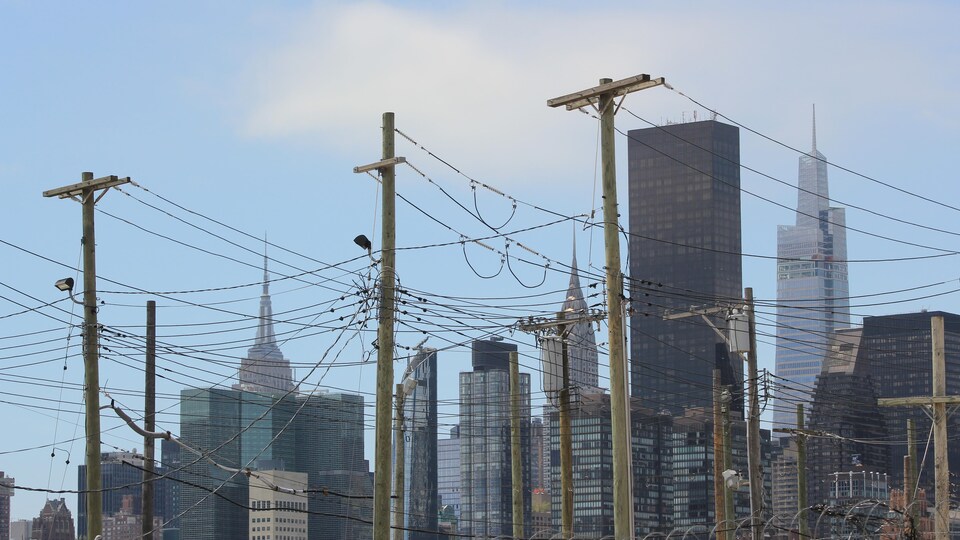NEW YORK-In April, Hydro-Québec received the green light for its second major electricity export project to the United States: the Champlain Hudson Power Express (CHPE) in New York State. If it can’t shelter opponents like in Maine, the social acceptability of this project is somewhat different, starting with the disadvantaged neighborhoods of the Big Apple.
In Queens borough, which faces Manhattan on the other side of the East River, a power station stands out with its four gigantic red and white chimneys. The so -called Big Allis, which runs on natural gas and fuel oil, provides more than 20% of the electricity to the largest city in the United States.
The plant and other small neighborhoods emit a lot of toxic gas during peak hours to energize skyscrapers, so New Yorkers call this areaAsthma Alleyor the asthma corridor.
Community organizer Louie P. Sosa met Radio-Canada at the epicenter of this corridor, at the crossroads of several social housing units. Here he grew up with his mother and brother who had asthma.
It receives such a breath of fresh air the commissioning by 2026’s CHPE. 1,250 megawatts of Quebec hydroelectricity will meet up to 20% of New York’s electricity needs.
This project provides help to bring green energy to New York, argues Mr. Sodium, and a lot of hope. The hope is that polluting power stations will close.
A puzzle piece
The 603-kilometer, $ 6.8 billion underground line, partially buried beneath Lake Champlain, will run from Hydro-Québec’s Hertel substation in La Prairie, Montérégie, and connect to the distribution network in Queens. Transmission Developers Inc., which is wholly owned by Blackstone, is the U.S. partner of the state-owned company in this venture.
The project is huge, but necessary, according to Julie Tighe, president of the New York League of Conservation Voters. We have climate law that requires us to switch to 70% clean energy by 2030, he explained. Currently, 85% of electricity is produced from fossil fuels.
Although he could not say with certainty that the polluting power stations would stop their activities, he said he was convinced that they will be used gradually in the clean energy that will be received.
His words reflect Costa Constantinides, a former city councilor who acknowledged his involvement in the environmental cause. The one who is now head of the support organization for the unfortunate children Variety Boys & Girls of Queens is mainly seeing the CHPE as a piece of the puzzle among other projects to remove polluting power plants from the landscape and transform IAsthma Alley in the renewable energy corridor.
Opponents who are not very talkative
Major interest groups opposed to the Hydro-Quebec line ignored or denied our interview requests.
New York’s Independent Power Producers and New York’s Alliance for Clean Energy have already argued that the contract only provides an obligation to deliver energy in the summer, and not during the winter. To environmentalists, the Riverkeeper and the Sierra Club believe the reservoirs of the dams prove to be a source of greenhouse gas emissions due to the decay of flora in the flooded territories.
The owner of the Big Allis plant, Rise Light and Power, has promised to close its facilities if its proposed line that will carry wind and solar energy produced in the upstate is approved.
However, this was denied by the New York State Energy Research and Development Authority, much to the chagrin of the president of the Utility Workers Union of America Local 1-2. The union represents workers in the electrical industry in New York State. James Shillito points out that there are many ways to make the Hydro-Quebec project equivalent to the state with its residents, and keeping taxpayers ’money and costs here.
” We love Canadians, but we don’t want to give them our jobs. “
Legal challenges are still possible

Although a contract was signed with the State of New York, Hydro-Québec did not claim that it was immune to a legal challenge that could jeopardize its high-voltage line.
There are companies whose leaders refuse to shift energy because it threatens their business model, CEO Sophie Brochu lamented in an interview. These people will not stop attacking anything that changes in different ways.
” In America, part of the business is to sue and have claims. So immune? I do not think so. “
The fate of the New England project, the New England Clean Energy Connect (NECEC), is currently in the hands of the Maine Supreme Court, where the airline must transit to get to Massachusetts. The court must consider the constitutionality of a referendum that prompted in November the construction ban when it was in order.
Rush after the decline in New Hampshire in 2018, the NECEC came against strong opposition from civil society, especially since it was leading to the destruction of forests.
In New York State, the CHPE has been formed since 2008. Hydro-Québec is involved with communities, donating large amounts to organizations, including US $ 625,000 to the Variety Boys & Girls Club of Queens.
What we experienced in New York was certainly known by what we experienced in Maine, Sophie Brochu said. In Maine, our deployment was different, we deployed a little later, but we still deployed to communities.
But maybe it’s too late, he agreed. The promised US $ 258 million in economic benefits is unconvincing to most Mainois.
The state-owned company is betting heavily on these two export projects, the last of which it plans. Potential revenues of $ 50 billion – $ 37.5 billion for CHPE and 12.5 billion for NECEC – Stay in balance for the next two decades.
Mathieu Dion (go to author page)
Source: Radio-Canada
